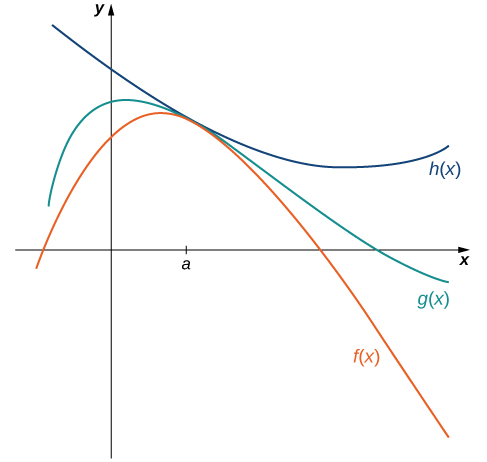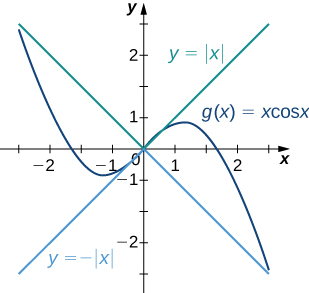The Squeeze Theorem
The techniques we have developed thus far work very well for algebraic functions, but we are still unable to evaluate limits of very basic trigonometric functions.
The next theorem, called the squeeze theorem, proves very useful for establishing basic trigonometric limits.
This theorem allows us to calculate limits by “squeezing” a function, with a limit at a point [latex]a[/latex] that is unknown, between two functions having a common known limit at [latex]a[/latex].

The Squeeze Theorem
Let [latex]f(x), \, g(x)[/latex], and [latex]h(x)[/latex] be defined for all [latex]x\ne a[/latex] over an open interval containing [latex]a[/latex]. If
for all [latex]x\ne a[/latex] in an open interval containing [latex]a[/latex] and
where [latex]L[/latex] is a real number, then [latex]\underset{x\to a}{\lim}f(x)=L[/latex].
How To: Solve Trigonometric Limits Using the Squeeze Theorem
- Confirm the function shows an indeterminate form that the Squeeze Theorem can address.
- Find two bounding functions, [latex]g(x)[/latex] and [latex]h(x)[/latex], that satisfy [latex]g(x)\le f(x)\le h(x)[/latex].
- Ensure [latex]g(x)[/latex] and [latex]h(x)[/latex] approach the same limit at the point of interest.
- Use the established bounds to deduce the limit of [latex]f(x)[/latex]. If [latex]g(x)[/latex] and [latex]h(x)[/latex] have a common limit [latex]L[/latex], then [latex]\underset{x\to a}{\lim}f(x)=L[/latex].
Apply the Squeeze Theorem to evaluate the limit [latex]\underset{x\to 0}{\lim}\frac{\sin{x^2}}{x}[/latex].
First start by identify bounding functions. We know that [latex]-1\le \sin{x^2}\le 1[/latex].
Next, divide these inequalities by [latex]x[/latex].
[latex]\frac{-1}{x}\le \sin{x^2}\le \frac{1}{x}[/latex]
Now, evaluate the limits of the bounding functions as [latex]x[/latex] approaches [latex]0[/latex].
Both [latex]\frac{-1}{x}[/latex] and [latex]\frac{1}{x}[/latex] approach infinity as [latex]x[/latex] approaches [latex]0[/latex], but since [latex]\frac{\sin{x^2}}{x}[/latex] is sandwiched between them, we deduce that
[latex]\underset{x\to 0}{\lim}\frac{\sin{x^2}}{x}=0[/latex]
due to the squeeze theorem.
Apply the Squeeze Theorem to evaluate [latex]\underset{x\to 0}{\lim}x \cos x[/latex].
